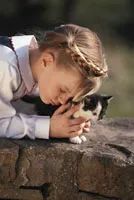What Spring Can Teach us About Our Sensitive Children
About Sensitive Children
In a recent webinar by Age of Montessori entitled Understanding the Special Sensitivities of Today’s Children presenter Maureen Bright shares her wisdom about how parents, teachers, and care givers can look into the consciousness of especially sensitive (sensory, not emotionally) children, in order to help them cope with our over-stimulating world. If you have not had the opportunity to watch this profoundly insightful webinar, please do so here. You’ll be glad you did.
 Maureen speaks about the cycle of growth which all children experience, and the importance of not interrupting this process as it unfolds. Often, it can appear to adults that the child is inactive or even unresponsive, while— in fact— there is a tremendous amount of growth and development going on under the surface.
Maureen speaks about the cycle of growth which all children experience, and the importance of not interrupting this process as it unfolds. Often, it can appear to adults that the child is inactive or even unresponsive, while— in fact— there is a tremendous amount of growth and development going on under the surface.

Maureen uses the phrase “winter proceeds spring.” In other words, a tree may appear to be inert during the winter. But we know that this time of dormancy is essential to the trees development and eventual springtime blossoming. So too are our children. Perhaps you have asked your child to come listen to a story. She nods in agreement but 10 minutes later, you find her still sitting there playing with a toy. It is important that we understand that this child is not blatantly disobeying or ignoring you. She is in the midst of a cycle that, by nature, she will feel a need to complete.
Beneath the Surface
When it comes to our sensory-sensitive children, it takes a lot for them to be able to clear away the overload of sensory input that they experience regularly, and focus on one stimuli. If at all possible, children should be given the room and time they need for growth. Caretakers should refrain from interrupting, even for positive feedback. Save the praise and accolades for after they have emerged from their deep state of concentration.
Maureen uses the beautiful imagery of a butterfly life cycle to illustrate her point. We all know that the butterfly goes through the full cycle of egg to caterpillar to cocoon to adult. This cycle cannot be rushed. Nature sets the pace and, if not interrupted, the cycle will unfold in its own time. Also, the pupa needs a period of rest. It may appear as if nothing is happening on the outside of a cocoon, but we now that a miraculous transformation is taking place inside.
Think of sensitive children as those little pupa, when their needs are met, and they are given a safe place of rest, they are able to develop into something uncommonly beautiful.
“The teacher must derive not only the capacity, but the desire, to observe natural phenomena. The teacher must understand and feel her position of observer: the activity must lie in the phenomenon.”
http://www.naturalbeachliving.com/2016/03/caterpillar-butterfly-ideas.html





















